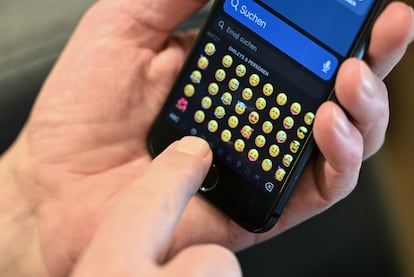The emoji revolution and how the thumbs up came to be passive aggressive and old-fashioned
The use of certain symbols in communication, like wearing certain clothes, broadcasts which generation we belong to

TikTok has become the preferred stage for content creators highlighting the generational differences between boomers, millennials and centennials. Now a study reveals that these TikTok reels reinforce both the negative and positive traits of boomers — an ageist prism that, according to the study’s authors, directly harms the mental health of its targets. Although one of the aspects that separate members of Generation Z or centennials, born between 1995 and 2010, from millennials, born between 1980 and 1995 — at least in the online universe — is the length of their socks, with Gen Z favoring calf length, the use of emojis can inject a bittersweet vibe into conversations between people of different ages.
The emoji that causes the most grief is, paradoxically, the thumbs-up emoji, which members of Generation Z consider passive aggressive, while older people believe it is used as a sign of affirmation and agreement. Curiously, according to a study launched by Wavemaker Spain, so many of us love the thumbs-up emoji, that those dismissing it as passé are not going to have it easy, even though its use, as revealed by a Perspectus Global survey, makes people between 16 and 19 think of the user as “officially old.” Apparently, it is enough to show your ankles or put an innocent emoji with a thumbs-up for our anti-wrinkle creams to be rendered redundant.
But how has the meaning of a simple thumbs up changed so radically? Linguist Adam Aleksic explains on his social networks: “Now it has a new function and is used to stop a conversation,” he says. “When you use this emoji at the end of a message, it seems somewhat blunt, because it indicates that the conversation is over. That is why some people think that its use is passive aggressive. It was not always like that, because people used to use it with absolute sincerity. A Canadian judge even ruled that the thumbs-up emoji can be recognized as a valid means of sealing a contract, but when a gesture is overused, it becomes insincere and loses its meaning.” He adds that this is precisely what happened with the laughing emoji, which ended up having a sarcastic nuance; now it is the turn of the thumbs-up emoji.
“Despite having an initial meaning established by Unicode, emojis are pictograms that reinforce, complement or soften the text,” Pavel Sidorenko Bautista, professor and researcher at the International University of La Rioja, tells EL PAÍS. “Their meaning adapts according to the context, the audience and the circumstances. For example, eggplant has come to mean penis. Peach, ass. The reason is that the algorithms of many platforms censor these words and there are no explicit emojis to replace them. However, among cooks or housewives, an eggplant or a peach are still an eggplant and a peach.”
Bautista says that Generation Z wants to break with previous age demographics. “The traditional smiley face, as with the thumbs up, has a negative connotation for this group of users, so to express joy, they use the skull!” He believes that the reason millennials and centennials actually employ emojis differently is that it was the millennials who were around during their creation and implementation in the digital conversation.
“They have accompanied the process, and, in many instances, they have been prime movers. However, when Generation Z began to use the internet, social networks were in full expansion. Emojis were already several generations old, and, in that context, there was still no convention about their aesthetics, so each technology and each platform developed its own versions,” he says, adding that centennials have no truck with meanings being imposed and use these graphic resources as it suits them. “Their use has already been scorned in some specific media, such as WhatsApp, where the sticker — a simplification of the meme — is better suited to their idiosyncrasies.”
While it might seem that understanding the meaning of emojis is intuitive, in reality assimilating both what they mean and the subtext may not be so easy. As Jieun Kiaer explains in Emoji Speak: Communication and Behaviours on Social Media (Bloomsbury Academic, 2023), there is no dictionary that can include all the meanings of emojis in a context and register-sensitive way. “Emoji meanings must be carefully considered according to context. While the thumbs-up emoji may be seen as a positive sign of approval in many cultures, it could be interpreted as an offensive gesture in Greece and the Middle East. Therefore, it is useful to have some cultural knowledge when using them,” Kiaer points out.
Keith Broni, the world’s first emoji translator, explained to the Daily Mail the importance of taking into account people from younger generations. “In fact, someone from Generation Z could also see the face that shows a slight smile as highly performative and even as slightly passive aggressive,” Broni says. Although he believes that nowadays, using emojis in work emails is appropriate, as he considers that they are indicators of emotional expression and help to generate a sense of camaraderie within a relationship, it is vital to take into account generational differences to avoid a thumbs up becoming a definitive goodbye. If at some point a simpler communication is required, not even a smiley face can escape the communication differences between the generations.
Sign up for our weekly newsletter to get more English-language news coverage from EL PAÍS USA Edition
Tu suscripción se está usando en otro dispositivo
¿Quieres añadir otro usuario a tu suscripción?
Si continúas leyendo en este dispositivo, no se podrá leer en el otro.
FlechaTu suscripción se está usando en otro dispositivo y solo puedes acceder a EL PAÍS desde un dispositivo a la vez.
Si quieres compartir tu cuenta, cambia tu suscripción a la modalidad Premium, así podrás añadir otro usuario. Cada uno accederá con su propia cuenta de email, lo que os permitirá personalizar vuestra experiencia en EL PAÍS.
¿Tienes una suscripción de empresa? Accede aquí para contratar más cuentas.
En el caso de no saber quién está usando tu cuenta, te recomendamos cambiar tu contraseña aquí.
Si decides continuar compartiendo tu cuenta, este mensaje se mostrará en tu dispositivo y en el de la otra persona que está usando tu cuenta de forma indefinida, afectando a tu experiencia de lectura. Puedes consultar aquí los términos y condiciones de la suscripción digital.
More information
Archived In
Últimas noticias
Most viewed
- Sinaloa Cartel war is taking its toll on Los Chapitos
- Oona Chaplin: ‘I told James Cameron that I was living in a treehouse and starting a permaculture project with a friend’
- Reinhard Genzel, Nobel laureate in physics: ‘One-minute videos will never give you the truth’
- Why the price of coffee has skyrocketed: from Brazilian plantations to specialty coffee houses
- Silver prices are going crazy: This is what’s fueling the rally











































